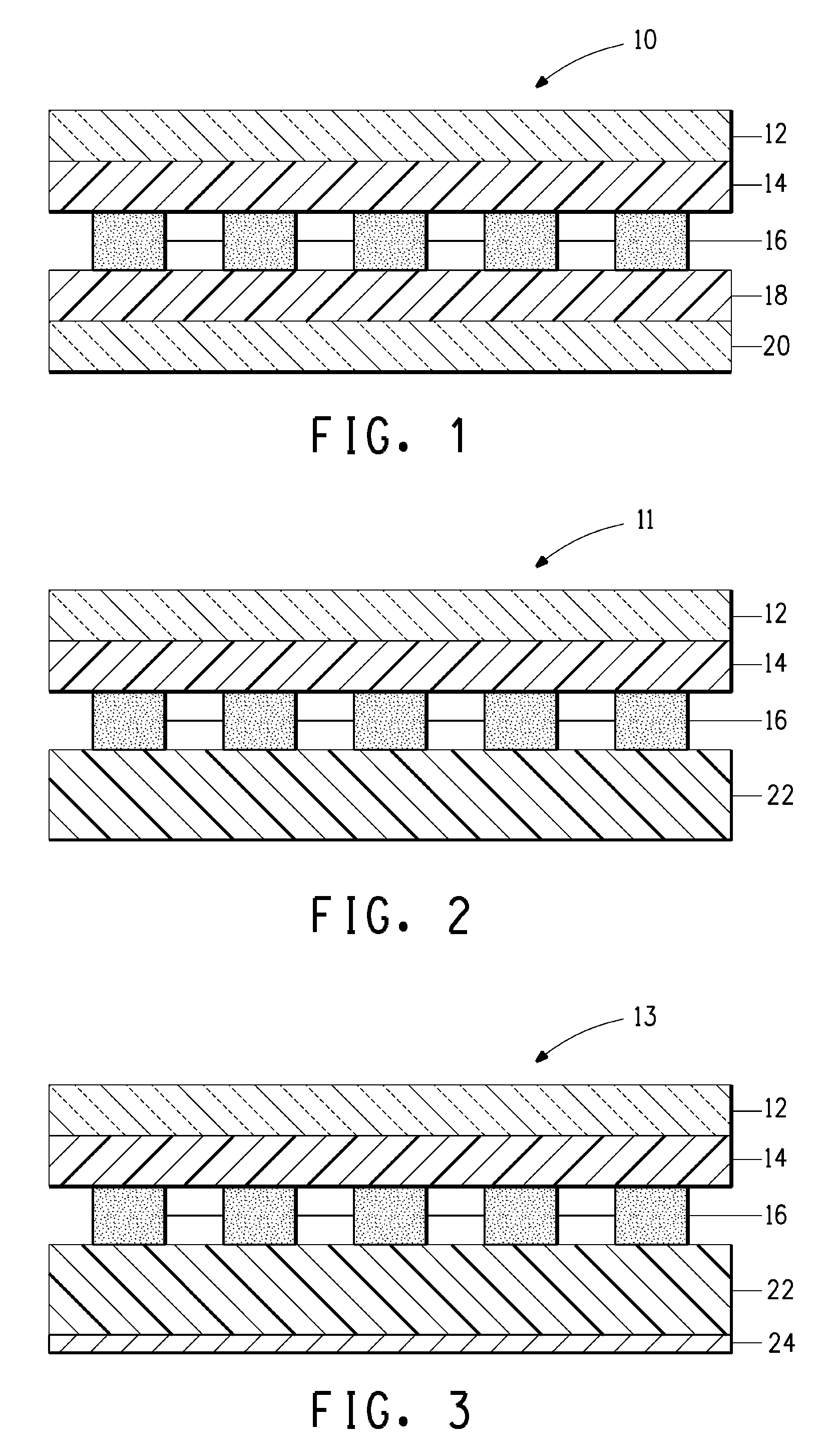Photovoltaic module with chlorosulfonated polyolefin layer
a photovoltaic module and chlorosulfonated polyolefin technology, applied in the direction of synthetic resin layered products, chemistry apparatus and processes, other domestic articles, etc., can solve the problems of back-sheet delamination and degradation
- Summary
- Abstract
- Description
- Claims
- Application Information
AI Technical Summary
Benefits of technology
Problems solved by technology
Method used
Image
Examples
example 1
[0071]A lamination sample was made using sample slab no. 1 on Table 1 above. The lamination was accomplished by preparing a layered structure having a 5 mil thick cell support release sheet made of Teflon® PTFE, followed by a mono-crystalline silicon solar cell with a back side contact made of aluminum, followed by the 25 mil thick single layer of CSPE sample slab no. 1 of Table 1. The CSPE sample slab no. 1 was cut to approximately 4 inches long and approximately 5 inch wide so as to have a similar length and width as the mono-crystalline silicon solar cell.
[0072]The layered structure was placed into a lamination press having a platen heated to about 120° C. The layered structure was allowed to rest on the platen for about 6 minutes to preheat the layered structure under vacuum. The lamination press was activated and the layered structure was pressed together using 1 atmosphere of pressure for 14 minutes to permit the CSPE sample slab to encapsulate silicon solar cell.
[0073]The lam...
example 2
[0076]A lamination sample was made by the same process as in Example 1B under the same process conditions, except that the CSPE sample slab no. 1 described in Table 1 was replaced with the CSPE / hot melt adhesive sample slab no. 2 described in Table 1 above.
[0077]The lamination sample was subjected to the damp heat exposure test described above for 1000 hours and then tested for peel strength. The CSPE / hot melt adhesive layer did not undergo significant degradation and the peel strength between the CSPE / hot melt adhesive layer and the solar cell was sufficiently high that the CSPE / hot melt adhesive layer could not be pulled from the silicon solar cell without breaking the silicon solar cell.
[0078]Another sample of the CSPE / hot melt adhesive slab no. 2 by itself was tested for dielectric breakdown using above described method. The average breakdown voltage was 14 KV.
[0079]Another sample of the CSPE / hot melt adhesive slab no. 2 by itself was tested according to the cut through test des...
example 3
[0080]A lamination sample was made by the same process as in Example 1B under the same process conditions, except that the CSPE sample slab no. 1 described in Table 1 was replaced with the CSPE / glycerol ester hydrogenated rosin tackifier sample slab no. 3 described in Table 1 above.
[0081]The lamination sample was subjected to the damp heat exposure test as described herein above for 1000 hours and then tested for peel strength. The CSPE / glycerol ester hydrogenated rosin tackifier layer did not undergo significant degradation and the peel strength was sufficiently high that the CSPE / glycerol ester hydrogenated rosin tackifier layer could not be pulled from the silicon solar cell without breaking the silicon solar cell.
[0082]Another sample of the CSPE / rosin tackifier slab no. 3 by itself was tested for dielectric breakdown using above described method. The average breakdown voltage was 15.1 KV.
[0083]Another sample of the CSPE / rosin tackifier slab no. 3 by itself was tested according t...
PUM
| Property | Measurement | Unit |
|---|---|---|
| weight percent | aaaaa | aaaaa |
| weight percent | aaaaa | aaaaa |
| weight percent | aaaaa | aaaaa |
Abstract
Description
Claims
Application Information
 Login to View More
Login to View More - R&D
- Intellectual Property
- Life Sciences
- Materials
- Tech Scout
- Unparalleled Data Quality
- Higher Quality Content
- 60% Fewer Hallucinations
Browse by: Latest US Patents, China's latest patents, Technical Efficacy Thesaurus, Application Domain, Technology Topic, Popular Technical Reports.
© 2025 PatSnap. All rights reserved.Legal|Privacy policy|Modern Slavery Act Transparency Statement|Sitemap|About US| Contact US: help@patsnap.com



